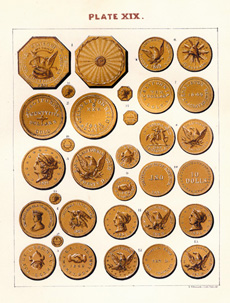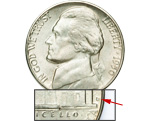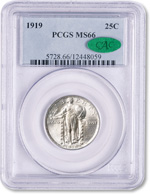Ways to Collect Coins
Types of collections

This color woodblock plate, from An American Numismatic Manual, was printed before the age of photographic reproduction.
Originally, U.S. coins were collected by type. In the mid-1800s, someone might have put together a collection of dollars by design type and date, but not by date and mint, as we do today. Then, in 1859, Dr. Montroville W. Dickeson published An American Numismatic Manual. This 256‑page book was the first comprehensive encyclopedia of U.S. coinage. Later, Augustus G. Heaton published A Treatise on the Coinage of the United States Branch Mints, which raised interest in the mint mark varieties. Collectors then began assembling all the different dates and mint marks of a particular series – such as Lincoln cents or Washington quarters.
Today, the coin hobby is still enjoyed in many ways, but collecting by date and mint mark is certainly America’s favorite. Since 1793, when the U.S. Mint began striking coins, most issues have carried their year of production on the obverse or “heads” side. Coins produced at branch U.S. Mints also carry a small letter or mint mark that indicates where it was struck. As you enjoy finding and purchasing those special dates and mint marks you need for your series collection, you’ll notice that there are some issues that are more difficult to find than others. Read more about the U.S. Mints.
Beyond collecting by date and mint mark, the possibilities of how to collect coins are endless! Depending on your interests, you can build a collection that's as unique as you are. One favorite way is a coin type collection, which is assembling coins of different designs. It may be coins of the 20th century, or coins of any one denomination, either way you get a full overview of coin designs and how they have progressed through time.
You can also put together a year set – one coin from each year within a series. This gives you an authentic, official souvenir from every year of a particular period in U.S. history! Another option is a theme collection. Whether you collect coins featuring Liberty, America's presidents, or historic buildings and monuments, you'll have fun searching for pieces to complete your own personal medley!
Determining value
A coin is not necessarily valuable merely because of age. For example, some Roman coins more than 1,600 years old can still be purchased today for $20 or even less! The value of a coin, like most items, is determined by supply and demand. Some coin types, such as Buffalo nickels or Mercury dimes, are more popular than others of the same denomination. Thus, more collectors are seeking the same coins, so their prices will be affected. A coin's value is determined by the interrelated factors of scarcity, condition and demand.
Perhaps more coins of an earlier date may have been produced than those of a later date, so coins that are far older may still be available. This is supply. Of course, it all depends on how many of each has been saved, and in what condition. A coin's condition (the state it has been preserved in) is an extremely important factor in its value. An Uncirculated piece may be worth ten times or thousands of times as much as an average circulated coin of the same date.
Those special “Key Dates”

The “D” mint mark on a 1950 nickel signifies a scarce, low-mintage coin.
In every U.S. coin series, there are certain issues or varieties that because of rarity and prominence are the “keys” to completing the series. Collectors prize them because there are so few to go around! Mint marks can be a major factor in the value of a coin. In 1950 for instance, the popular Jefferson nickel was produced at two different mints, Philadelphia (no mint mark) and Denver (“D” mint mark beside Monticello on the reverse). While the 1950 nickel is not as difficult to find (mintage of 9,847,386), the 1950‑D was produced only in very small quantities (mintage of only 2,630,030) and is scarce today. The 1950‑D (pictured) is the key date of the Jefferson nickel series.
Certified graded coins

Standing Liberty quarter, certified and encapsulated by PCGS, with CAC sticker
When learning how to collect coins, it is helpful to know that some coins have been certified and encapsulated. Those sold by Littleton must first meet our exacting grading standards, and then are graded by an independent service. When adding one to your collection, it's important to look at the coin within the holder to see if it appeals to you. The four independent grading services used by Littleton are PCGS, or Professional Coin Grading Service; NGC, or Numismatic Guaranty Corporation of America; ANACS, or American Numismatic Association Certification Service; and ICG, or Independent Coin Grading Company. These grading services have certified and encapsulated each coin in a sonically sealed holder, with a bar coded identification insert noting the coin, variety, date, and coin grade.
Coins in certification holders bearing oval green CAC (Certified Acceptance Corporation) stickers have been verified by CAC as solid, high‑end quality for the specified grade – with strong strikes and eye appeal, and no unattractive toning.
Some collectors prefer their coins in certified holders. First, it offers peace of mind to know that a third party has authenticated their coins. It is easy to ensure safe handling of your coins when they are individually sealed in a holder. And owning coins that have been certified by a single grading service can turn your collection into a very handsome display.
How to choose a series that’s right for you
Over the years, the U.S. Mint has produced a wide variety of coins, and Littleton has archival-quality albums for most. To choose a series, consider how much you like the design and composition of the coin, and the popularity of the series. Littleton Coin Company offers a wider selection of U.S. coins than any other company and can help you complete a variety of different collections. You can choose a single coinage series, or you may wish to work on several at once. Whichever way you choose, once you complete your collection, you’ll have a family heirloom that will be treasured for generations to come.
More information on caring for and storing your coins

